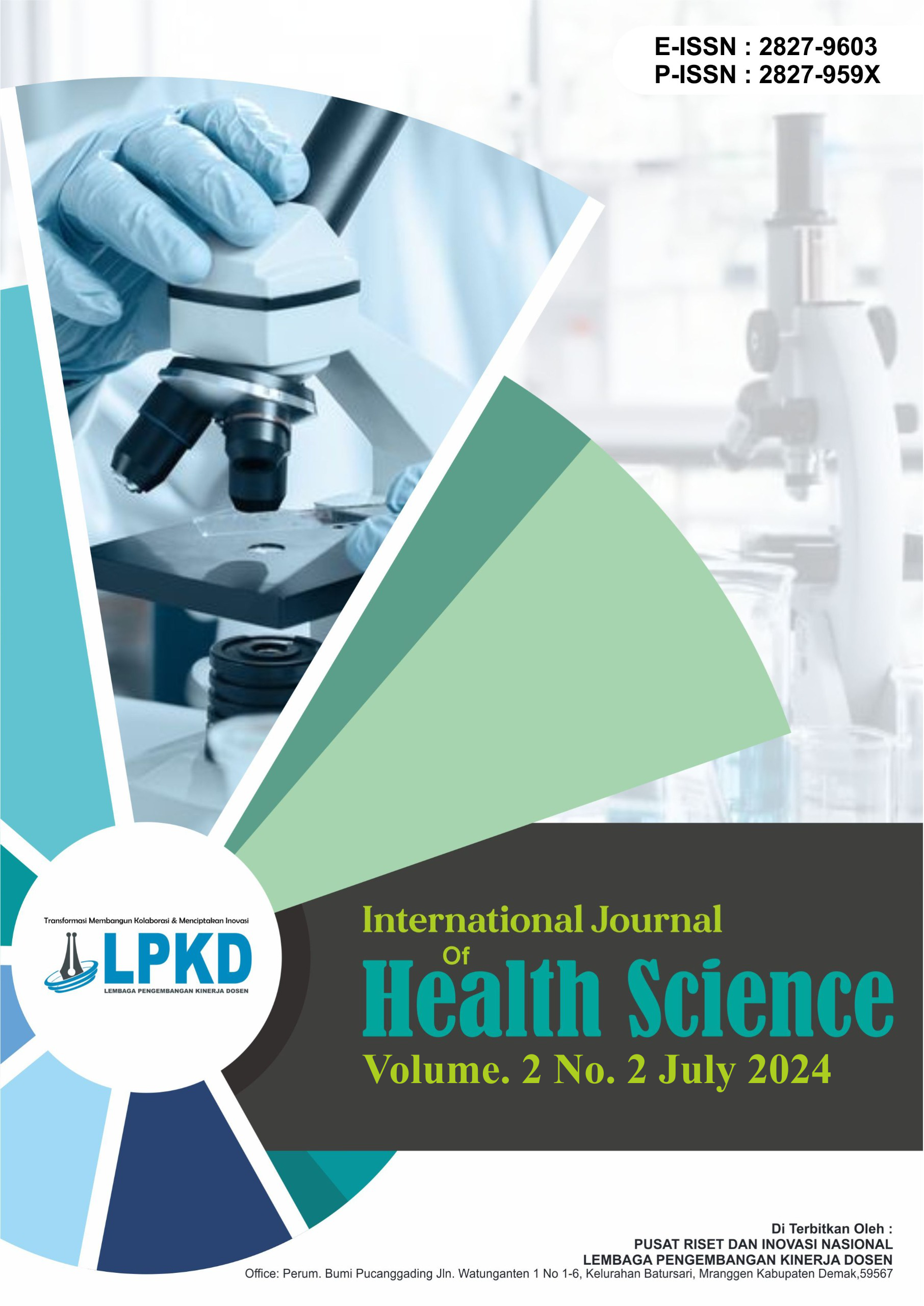PATTERNS OF ANTIBIOTIC PRESCRIPTION FOR THE TREATMENT OF URINARY TRACT INFECTIONS IN KOTARAJA PUBLICAL CENTER
DOI:
https://doi.org/10.55606/ijhs.v2i2.1418Keywords:
Prescribing Pattern, Antibiotics, Urinary Tract InfectionAbstract
Urinary Tract Infection (UTI) is an infectious disease that is often found in general practice. Urinary tract infection (UTI) can be defined as the presence of bacteria in the urine where these bacteria may invade the tissues of the urinary tract. The type of research used in this research is descriptive research. This research was conducted in June 2021, in the medical records section of the Kotaraja Health Center, Jayapura City. The population in this study were all patients with UTI who were treated at the Kotaraja Publical Center in June - December 2020 with a total of 30 patients. The results showed that there were more female patients than male, namely 17 people (57%). most patients came from the age group 26-35 years as many as 11 people (37%). The most dominant type of antibiotic prescribed was ciprofloxacin in 24 patients (80%). The most dominant group of prescribed antibiotics was Fluroquinolone as many as 24 patients (80%). The most widely used dose of antibiotic preparations was Ciprofloxacin 500 mg for 24 patients (80%). The most frequent duration of antibiotic administration was 5 days for ciprofloxacin as many as 20 patients (67%). Conclusion: The most frequently used antibiotic at the Kotaraja Publical Center is Ciprofloxcacin
Downloads
References
Adib,M., 2011. Infeksi Tersering Pada Penderita Infeksi Saluran Kencing Di Laboratorium Klinika Surabaya. Jurnal Adib Baru, Akademi Analis
Kesehatan, Malang.
Alfi, H. Sholihah., 2017. Analisis Faktor Resiko Kejadian Infeksi Saluran Kemih (ISK) oleh Bakteri uropatogen dipuskesmas cipatat.
Badan Pengawas Obat dan Makanan Republik Indonesia (BPOM RI), 2015, Informasi Obat Nasional Indonesia (IONI, http://pionas.pom.go.id/ioni/bab5/infeksi/51-antibakteri diakses pada 31 Agustus 2021
Colgan, R., Williams, M., 2011, Diagnosis and Treatment of AcuteUncomplicated Cystitis.
Coyle, E.A., & Prince, R.A., 2005. Urinary Tract Infection and Prostatitis.
Departemen Kesehatan RI. 2011. Pedoman Umum Penggunaan Antibiotik. Jakara : Kementerian Kesehatan Republik Indonesia.
Departemen Kesehatan RI. 2013. Keputusan Menteri Kesehatan Republik Indonesia No 5 Tahun 2013 Tentang Pedoman Tatalaksana Infeksi Saluran Kemih.
Departemen Kesehatan RI. 2014. Survei Demografi dan Kesehatan Indonesia. Jakarta: Kementrian Kesehatan Republik Indonesia
Dharma,P.S., 2015. Penyakit Ginjal : Deteksi Dini dan Pencegahan. CV Solusi Distribusi, Yogyakarta.
Dipro, et al 2015. Pharmacotherapy Handbook, Ninth Edition, McGraw-Hill Education, USA.
Edel Weisela, 2015. Resiko Infeksi Nosokomial Saluran Kemihs
Febrianto,A.W., Mukaddas,A., Faustine,I., 2013. Rasionalitas Penggunaan Antibiotik pada Pasien Infeksi Saluran Kemih (ISK) di Instalasi Rawat InapRSUD Undata Palu. Prodi Farmasi, Uniersitas Tadulako. Palu. Online Jurnal of Natural Science Volume 2, 9(2):87-92.
Grabe, R.Bartoletti, T.E. Bjerklund johansen, T.Cai, M.Cek, B.koves, K.G.Nabe, R.S. Pickard, P. Tenke, F. Wagenlehner, B.Wult. 2015. Guideline on urological infection. Europian Association of Urology.
Ikram, A.F.Z., 2015. Hubungan Antara Jumlah Leukousit dengan kultur Urin pada Infeksi Saluran Kemih di RSUP H.Adam Malik. Karya Tulis Ilmiah. Fakultas Kedokteran, Universitas Sumatera Utara, Medan.
Katzung, Bertram G. (2010). Farmakologi Dasar dan Klinik (terjemahan), Ed.10, Penerbit Buku Kedokteran EGC, Jakarta.
Kim, B,R., Lim, J.H., Lee, S.A. et.al. 2012. The relation between postvoid residualon occurence of urinary tract infection after stroke in rehabilitation unit.Ann rehabil Med36 (2) : 248-253
M.Clevo Rendy., Margareth. 2012. Asuhan Keperawatan Medical Bedah Penyakit Dalam Edisi 1, Nuha Medika : Yogyakarta.
Nofriaty R., 2010, Evaluasi Penggunaan Antibiotik pada Pasien Infeksi Saluran Kemih di Instalasi Rawat Inap Rumah Sakit Umum Daerah Dr. Moewardi Surakarta Tahun 2009, Skripsi, Fakultas Farmasi Universitas Muhammadiyah Surakarta.
PERMENKES RI, 2011, Pedoman Umum Penggunaan Antibiotik, Kementrian Kesehatan RI, Jakarta, 874.
Purnomo, 2014.Dasar-dasar Urology Edisi Ketiga. CV Sagung Seto, Malang.
Rajabnia, M., Gooran S., Fazeli, F., Dashipour, A, 2012. Antibiotic Resistence Paltern in Urinary Tract Infection in Imam-Ali Hospital Zahedan 2010-2011. Zahedan Journal of Research in Medical Science.
Sarimanah, J, Theresia Neot, Tessa Chrisma. 2013. Pola Peresapan Obat di Apotek Asri, Klaten Tahun 2008. USB, Jawa Tengah
Semaradana,W.G.P., 2014. Infeksi Saluran Kemih Akibat Pemasangan Kateter, Diagnosis dan Penatalaksanaan, Fakultas Kedokteran, Universitas Udayana, Denpasar, Bali. CDK- 221.Volume 41 Nomor 10.
Sri Haryanti, 2010. Pola Peresepan Antibiotika pada ISK pasien rawat jalan di RS Panti Rapih Yogyakarta
Syamsuni, H. A., (20114). Ilmu Resep. EGC : Jakarta
Downloads
Published
How to Cite
Issue
Section
License
Copyright (c) 2022 International Journal Of Health Science

This work is licensed under a Creative Commons Attribution-ShareAlike 4.0 International License.







